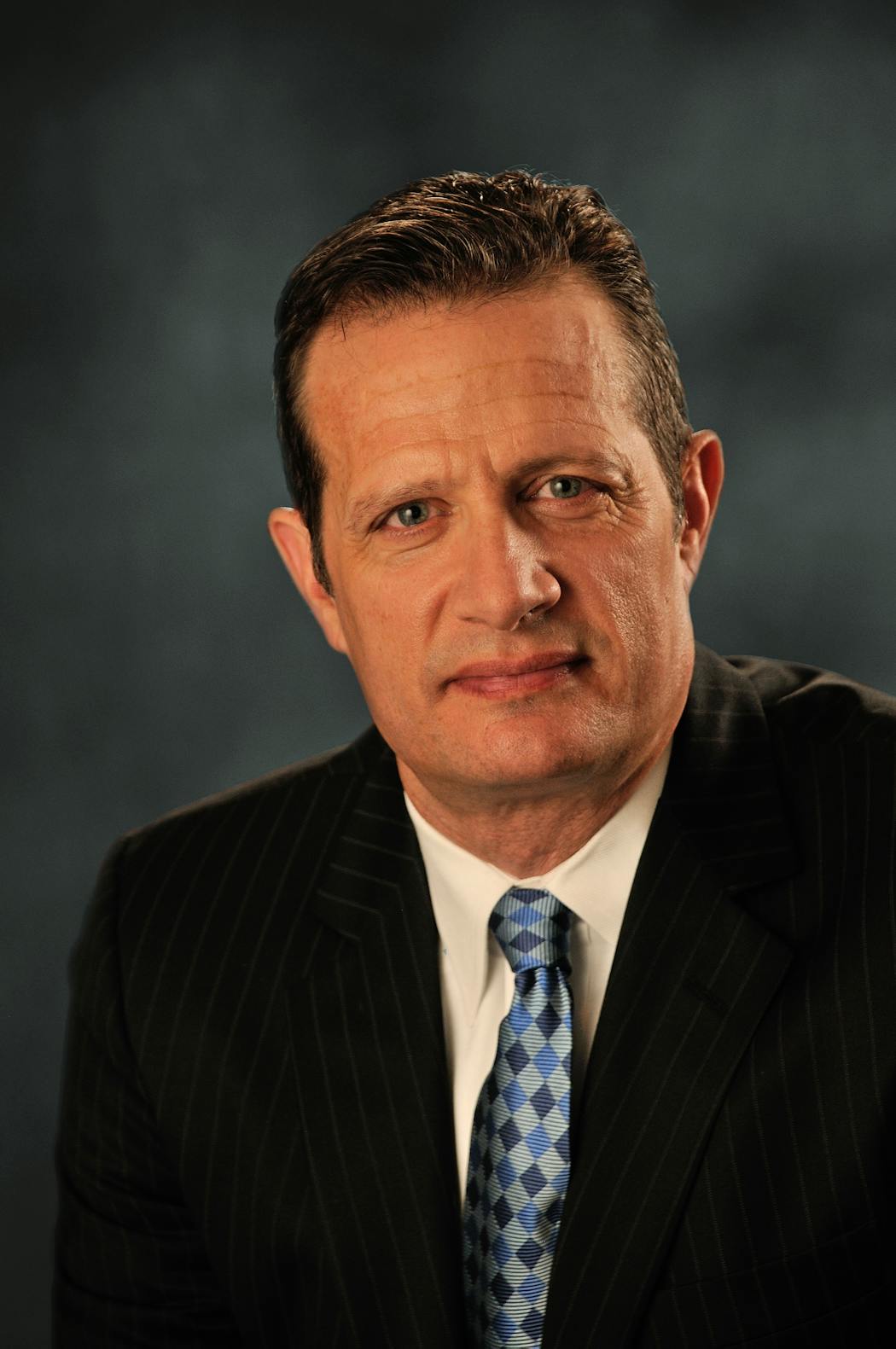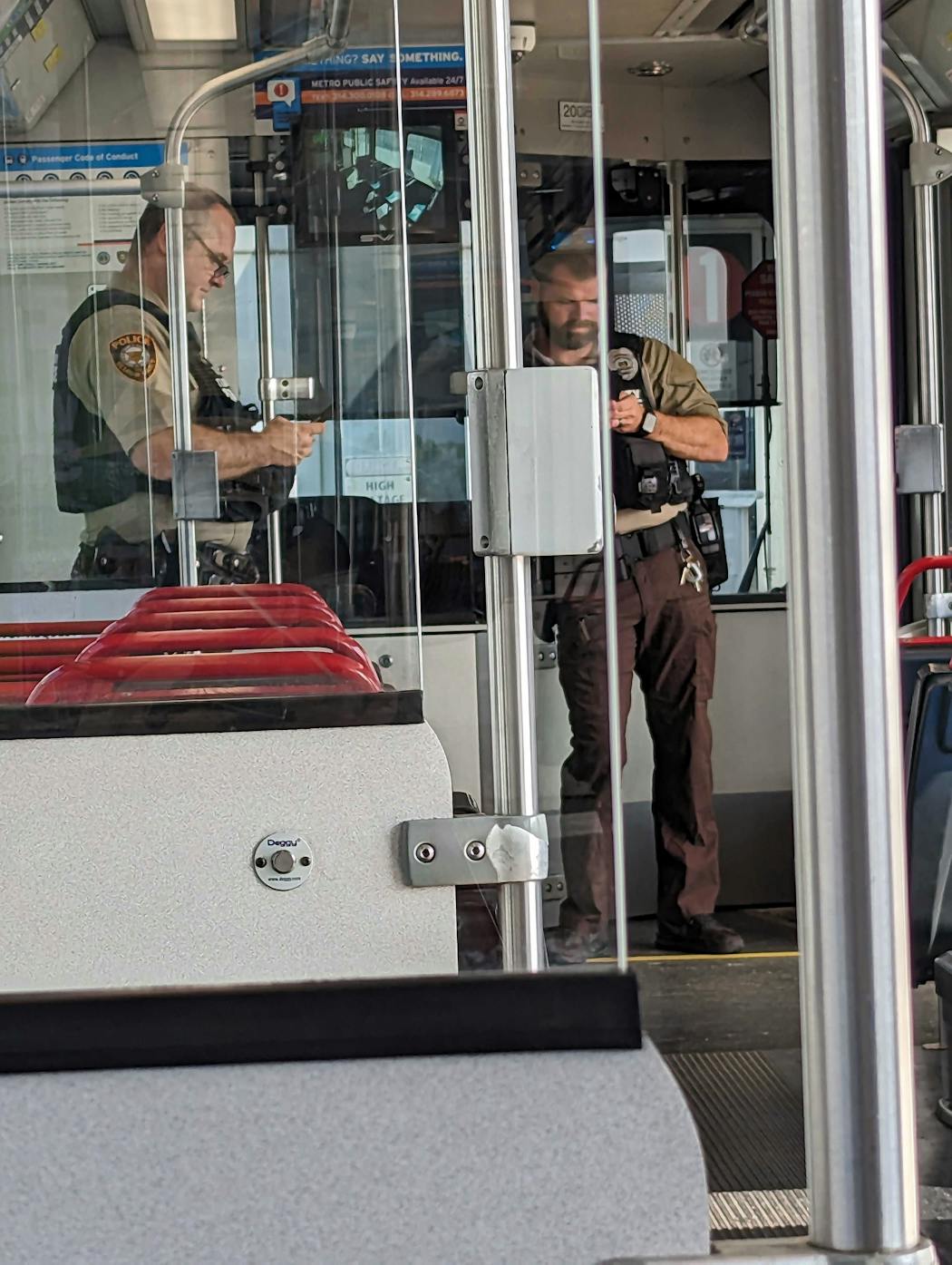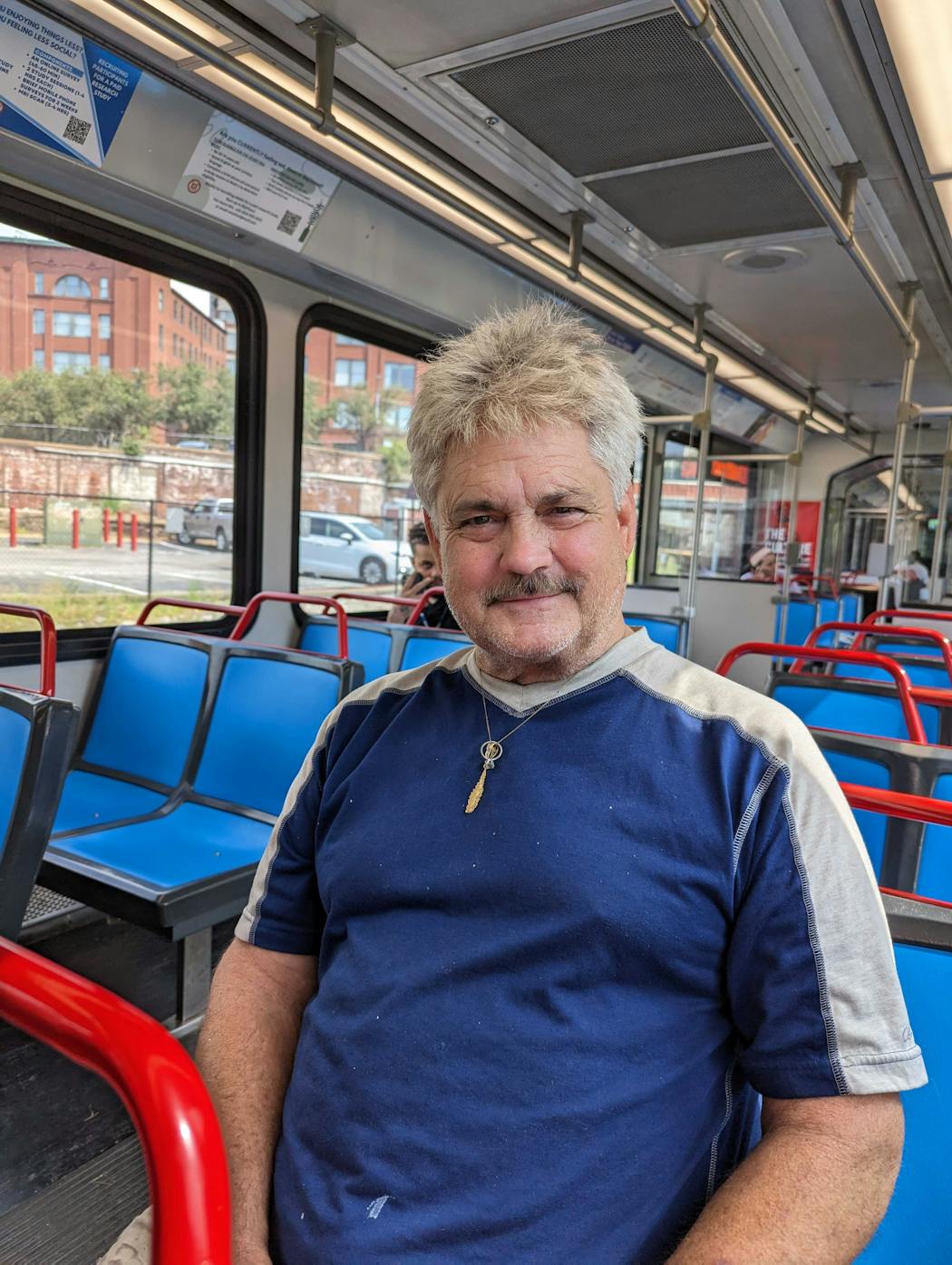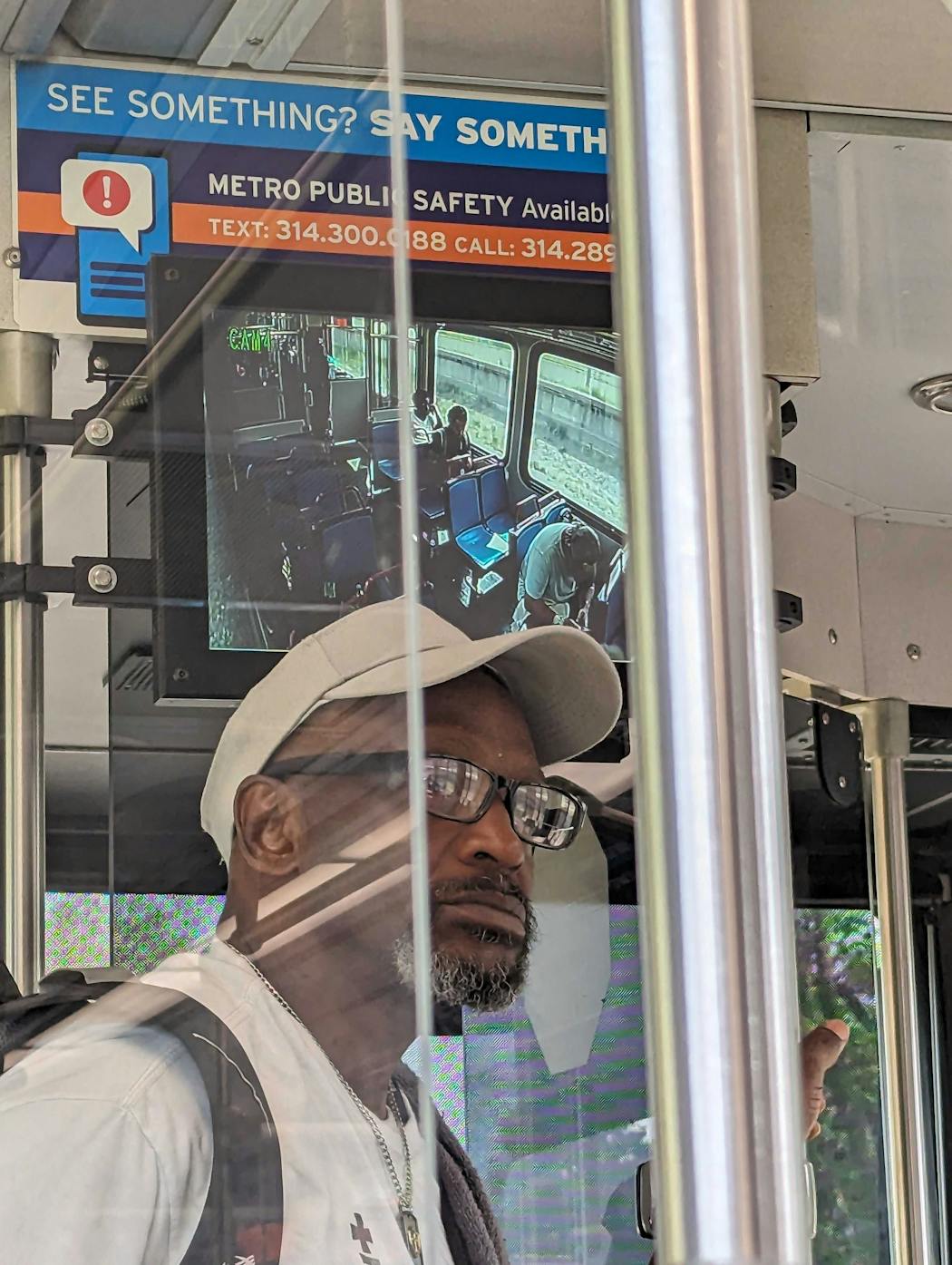The safety-first effort in St. Louis: 'We had a problem to solve'
Opinion editor's note: Editorials represent the opinions of the Star Tribune Editorial Board, which operates independently from the newsroom.
SYSTEMIC INSECURITY
A special report from the Star Tribune Editorial Board about making riders feel safe on light rail.
•••
ST. LOUIS, Mo. — The light-rail system in the St. Louis area is second only to that in the Twin Cities area as the largest in the Midwest, with two lines and 38 stations that span two states. Like the Twin Cities, St. Louis also faced issues with rising crime and declining ridership that predated the pandemic.
After a series of violent crimes, leaders here took decisive action starting in 2018. They zeroed in on one element above all else: rider safety. The overhaul that followed changed the city's entire approach, with a single-minded, unapologetic, safety-first mindset that has resulted in a far more visible security presence, from police and other staff on trains to better use of technology.
The final phase is in progress now: a potentially groundbreaking conversion from the open "honor" system, like the one used in the Twin Cities, to one in which gates and fences ensure that only paid passengers have access to platforms and trains. The $52 million project includes a rarity in transit: a public/private partnership in which major downtown corporations are putting up $10 million to help fund the conversion.
Leading that effort has been Taulby Roach, CEO of Bi-State Development, the organization overseeing mass transit and an LRT system that runs from Missouri into Illinois — the only light-rail system in the country to cross state lines. Practically speaking, that means that a number of governmental entities must come together on anything of significance. In the two states, that includes three separate local jurisdictions and their law enforcement agencies.
How did Roach and others gain consensus from such disparate entities? "Well, it wasn't butterflies and rainbows that got us there," he said with a pained smile. The light-rail system, called MetroLink, was coming off two homicides just a month apart in 2017, and passengers were complaining about witnessing drug deals, smoking on trains, various crimes and ongoing harassment and threats — safety issues familiar to Twin Cities LRT riders.
"We had a problem to solve," said Roach, who took over in 2019. Despite multiple frustrations, he said, "you had to reach the point of 'We care about our communities, so what are we going to do about it?'"
Topping that list was a comprehensive analysis by a professional security consultant. The blunt report that followed listed shortcomings, a station-by-station assessment and 99 specific recommendations, among them an overhaul of law enforcement approaches. The consultant, Roach said, "was very critical of the past relationship with our law enforcement partners. It was a mess. Contentious. Not professional. Lots of finger-pointing. We had to strip all that down and start over."
The safety-first efforts didn't stop there. Every aspect of operations was reexamined with an eye toward keeping passengers safe. Then, because Roach felt more was needed to rebuild trust in the system, he resurrected an earlier proposal to physically secure the platforms. By spring 2024, the first four stations should be complete.
Roach's neck is out about a mile and a half on this endeavor. Critics have disparaged the new project as "marketing," while other naysayers continue to cast doubt on light rail's entire future. Nevertheless, Roach has forged a multi-jurisdictional compromise of the kind rarely seen in mass transit. A key element in building that consensus, he said, has been the singular focus on security, in all its forms, and passenger safety as an imperative.
Roach touched on a point that should resonate with Minnesotans. "As we looked through the arc of what we needed to accomplish, it was confidence in the system," he said. "This is a publicly supported system, so I need folks even out in the suburbs, who may not ever take light rail, to still understand it has value. Like any Midwestern community, they want to know that it's fair and that it's safe. We decided if we could make a bold step like [secured platforms], we could really change the reality and perception of this system." The system, he said, is one in which "the public has invested millions. And they were asking us to rethink public safety."
Roach said a real test of the secured-platforms project came when he approached major corporate leaders to help underwrite a public system. To his astonishment, they were eager to contribute. "Quite frankly, I was shocked at their willingness," he said. When they saw the program's focus on rider safety and securing platforms, he said, "I had these captains of St. Louis industry writing checks — the only return for which will be the health of our community."
Riding the rails in St. Louis
Visitors flying into St. Louis' Lambert International Airport are greeted by a light-rail platform adjacent to the airport itself. Tickets are purchased inside the airport, and a short elevator ride takes you to the platform that, on a sweltering morning in August, was spotless.
Within two stops, a pair of St. Louis County police officers boarded the train. They soon were joined by a private security agent clad in a neon-yellow top and black pants, with "Metro Security" emblazoned on the back. Affectionately known as "bumblebees," the agents are responsible for checking fares and adherence to the code of conduct, engaging with customers, answering questions and maintaining a visible presence.
On this morning, two to three such agents could also be seen on most stations heading into downtown St. Louis and across the state line in East St. Louis. Bi-State contracts with a private security company that provides about 150 such agents to MetroLink.
Next to the monitors are signs that urge passengers, "If you see something, say something," with phone numbers to call or text.
Officers said they were eager for the next phase, the gated platforms and fencing that they expect will make rail safer.
St. Louis resident Thomas Marchand, a frequent rider, said he has noticed a change from recent years and appreciates the extra safety measures he has seen, including more officers and agents. Pointing to one of the monitors, he said, "That's another thing that makes you feel a lot more comfortable. I can see what's going on across the entire car." He is eager, he said, for the secured platforms. Marchand turned his head in the direction of an older woman nearby, who was on oxygen and using a walker. "She's heading to the medical center," Marchand said of this friend. "I ride with her to make sure she's safe. The platforms can be where trouble starts." The medical center is one of the major stops along the line.
Safety first
To oversee the security overhaul, Roach selected Kevin Scott, general manager of security for Bi-State and the project leader for the Secured Platforms effort. Tall, burly and bald, Scott looks like the police chief he once was. Increasingly genial as the conversation continues, he also has a way of sizing up a visitor that makes that visitor wonder if she has any outstanding tickets. Scott is a stickler for transparency and teamwork — two values that proved essential to rebuilding relationships among the different stakeholder law enforcement agencies and the public at large.
The need for security on light rail has always been there "without question," Scott said. What has changed is the approach. "We have built a community and transit-based approach," he said. "We don't subscribe to heavy-handed police tactics. But we do subscribe to the importance of law enforcement."
To that end, MetroLink deploys an estimated 240 security personnel, drawing from law enforcement agencies, security agents and other staff. By contrast, the Twin Cities' Metro Transit has about 107 full-time sworn transit officers. That force is supplemented by a few dozen part-time officers and a small, undisclosed number of security guards.
Scott said the private security agents have proven extraordinarily effective for the St. Louis system. They handle "about 90% of all engagement with riders," he said, with police available if needed. "What the public wants to see, what comforts them, is seeing a uniformed presence on the system, whether it's to ensure code-of-conduct compliance or fare enforcement," Scott said. There is enough police presence aboard trains, he said, that passengers know help can be summoned quickly.
He said the new strategy "has completely transformed public safety" on the transit system and has led to "better relationships with customers." Overall, Scott said, the safety-first focus is "reducing the number of incidents on the system, and allowing our customers to enjoy safe, comfortable and convenient rides throughout the region."
Another cue that Twin Cities Metro Transit could take from St. Louis as it proceeds with hiring security agents is the attention MetroLink has paid to collaboration. Police, Scott said, are urged to "get to know security agents personally, to have a vested interest in them. There is no better tool to a police officer than a security agent who can be their eyes and ears. Our security officers know all the regulars. We want them all working together."
Force multipliers
Like its counterpart in Minnesota, Bi-State's MetroLink does not have endless resources, and no system can staff every car and line with public safety personnel. That's why, Scott said, "we rely a lot on force multipliers." Closed-circuit television with real-time monitoring 24 hours a day tops the list, he said. "But we also look at lighting, sight lines, pinch points [where foot traffic funnels to a single point], signage, bushes, everything, from a security perspective." The screen monitors on trains that allow passengers to see what's going on, he pointed out, "also ensure that if you're intending to make trouble, you now can see yourself, and you know whatever you do will be recorded in detail. We consider that a force multiplier."
Roach said when light rail first came online in St. Louis, "Our original system was designed with an operations paradigm." If a camera went into a station, it was focused on where the train pulled in. "Now, we focus on the people. Because we are moving people — not trains." The safety of the passenger, he said, is paramount "in everything we do." To that end, Scott tracks fare compliance carefully. "It is the foundation of security," he said. Weekly audits show fare compliance on MetroLink is 90%. Fare compliance on Metro Transit in the Twin Cities is unknown because the agency stopped tracking it during the pandemic and will not resume it until next month. In 2016, Metro Transit officials said the overall fare evasion rate in the Twin Cities was estimated at around 8% to 10%. Those numbers have not been updated — but should be.
The biggest force multiplier is in progress now in St. Louis. The Secure Platform Plan will feature roto-gate-type turnstiles at each station, tall structures with interlaced metal rods that permit one passenger through at a time. ADA-compliant gates will provide access for those in wheelchairs or with other boarding challenges. A new ticketing system will ensure fares are purchased and validated before riders can pass through the roto-gate to the platform where trains arrive. Perimeter fencing will further close off the platforms where needed.
The choice of gate, Scott said, was critical. "If you're putting in short turnstiles of the kind you see in movie theaters, that's a failure. If you put in something that people are going to climb over or crawl under, you just wasted $52 million." Scott said there was a push to have the first four stations completed by spring 2024 because officials "wanted something immediate to show people. We want to get them excited about this new level of safety that can be provided." The entire retrofit of all 38 stations should be complete by the end of 2025.
There is another tool, Scott said, seldom used but available when needed: barring serious or chronic offenders from riding. About 200 people have been barred for varying lengths of time since the plan was adopted in 2020 for weapons violations, felony assaults or other violations. It's worth noting that for such a program to be effective, there first must be enough security presence to track fare and code compliance.
Just as with law enforcement in general, Scott said, "about 10% of the riders cause 90% of the trouble. Get control of that 10%, and you've made the system much safer."
Meeting the challenge of homelessness
As in the Twin Cities, MetroLink has its share of homeless riders. Roach said that just because they are homeless, that "doesn't mean we don't deal with customers in a compassionate and empathetic way. They are human beings who need to be dealt with appropriately." So Bi-State partnered with Chestnut Health Systems, a professional mental health provider, to put social workers on the system and to help train agents and officers in mental health awareness and de-escalation.
"When the Chestnut teams came online," Roach said, "one of their biggest fans was our law enforcement personnel. Police don't want to do social work, and they're not trained for it." The teams, he said, hand out small backpacks with toiletries and even naloxone, a drug that reverses opioid overdoses. "It's a way to have a more positive interaction, oriented toward the humanity of our customers."
Roach and Scott say the security overhaul and platform project has strong support among the public because it addresses top concerns. A 2018 survey showed that 71% cited an inadequate security presence as their most urgent issue, with 60% concerned about passengers who flouted ridership rules.
Phase 2
During a summer meeting at Bi-State, a room filled with MetroLink engineers, designers and others was linked via Zoom with HTNB, the private contracting company building the gating system. They were tackling Phase 2, which includes platforms with more serious design challenges, including underground stations in downtown St. Louis. The group ticked through its lists, methodically checking every element: egress, sight lines, fence heights, gate footprints, emergency access, cameras, rights of way, drainage, signage — all from a security perspective. The original two lines run on existing railroad tracks. A future line is planned for street level, similar to light-rail stations such as the Government Plaza stop in Minneapolis. Asked if the planned roto-gate system could be adapted to such stops, engineers replied that they were working on just such an approach.
Afterward, Scott noted that even with the upgrades, "One thing we will never be is fully automated. That's not realistic. You have to have human assets, people ensuring security on the trains." Asked whether Bi-State had data to prove the new redesign would accomplish its objectives, Scott paused. "I'm not sure anyone has done a retrofit quite like this. There is no easy way to do this. You need a clear vision, get everyone pulling in the same direction." Then at some point, he said, "you put your head down and charge the hill."
Next: The situation in the Twin Cities, and what riders say.
YOUR VIEWS?
What ideas do you have for making light-rail transit safer and rebuilding public trust in the Twin Cities system? In addition to participating in the online commenting feature at the end of each of these articles, you can submit letters (up to 250 words) or commentaries (up to 700, for more complex arguments) here.




